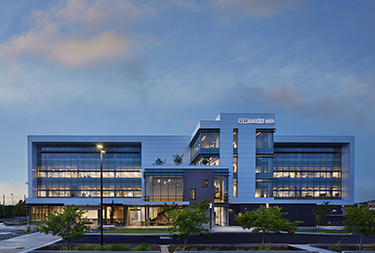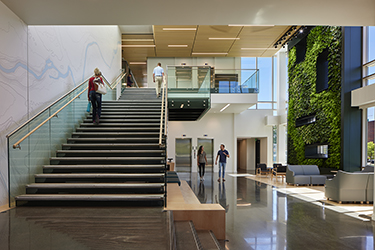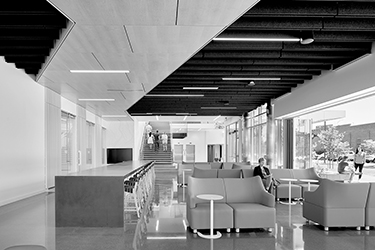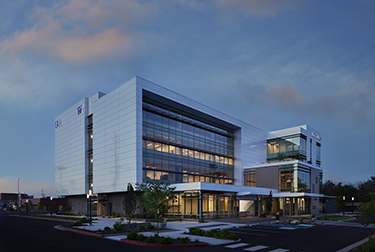|
Subscribe / Renew |
|
|
Contact Us |
|
| ► Subscribe to our Free Weekly Newsletter | |
| home | Welcome, sign in or click here to subscribe. | login |
Construction
| |
 |
October 6, 2022
Design can influence beyond its borders
CollinsWoerman

Rivera
|
When does a building become more than a physical space?
When its impact reaches far beyond its walls.
Scenically located on the oxbow of the Spokane River at the gateway to GU’s campus, the University of Washington-Gonzaga University Health Partnership’s building is more than a physical space — it’s a catalyst for advancing rural health care education and research locally and around the world.
The 109,000-square-foot building at 840 E. Spokane Falls Blvd. is the home of the UW’s School of Medicine and GU’s Department of Human Physiology. Designed by architect CollinsWoerman, the four-story facility features cutting-edge distance learning classrooms, integrated faculty offices, high-tech laboratories — including a state-of-the-art anatomy suite and a motion capture gait lab — as well as multiple study areas.
The facility is a culmination of UW and GU’s Health Partnership, Emerald Initiative, and McKinstry’s vision to transform the health and well-being of the region and expand access to rural health care education.
“This new building further strengthens the UW’s commitment to Spokane and our health partnership with Gonzaga,” UW President Ana Mari Cauce said. “We’re proud to partner with them and with clinicians around the region to train the next generation of doctors and health care providers who will provide excellent care to patients in Eastern Washington and beyond.”
In addition to being a place where students and faculty from UW and GU can collaborate and learn, the Health Partnership’s building serves a greater purpose — to help advance health care research and solutions that will give rural communities better access to affordable, quality care.
The facility is part of Emerald Initiative’s mission to create a medical cluster in the heart of Spokane. Emerald Initiative, an independently owned affiliate with McKinstry, envisions, develops, owns, and operates commercial real estate and alternative energy infrastructure. The organization seeks to grow medical and health education and biomedical research in Spokane to attract new industries, jobs, and investments to the area.
“We are excited to grow this industry cluster approach with the UW and GU Health Partnership,” McKinstry CEO Dean Allen said. “By leveraging the strength of Spokane’s health sciences community and renowned academic programs, we will help the region remain a top source for critical thinking, technology innovation and health care jobs.”
The new building is situated just north of the historic Spokane Inland Empire Railroad (SIERR) facility to create a 145,000-square-foot hub to advance interdisciplinary health sciences education, research, and innovation.
COMMUNITY IMPACT
The current strain in health care access is exacerbated by a shortage of medical providers in rural communities. The Washington State Department of Health reports that adults in rural communities face barriers to medical access at higher rates than those in non-rural communities.
There is a critical need for more health care professionals to provide care to these communities, and the Health Partnership’s building is a leap toward providing the much-needed care.
The Health Partnership builds upon the UW School of Medicine’s excellence in medical education and long-term presence in Eastern Washington and GU’s deep, local roots and top-ranked undergraduate and graduate health and life science programs. Their programs are a critical pipeline for the region’s next generation of health care professionals who will serve patients in the surrounding communities.
“The University of Washington School of Medicine has a 50-year history of excellence in medical education in Spokane and Eastern Washington,” UW School of Medicine interim Dean and UW Medicine and interim CEO Timothy H. Dellit said. “This world-class health and medical education building will ensure that UW medical students in Spokane have access to an exceptional learning environment and the tools necessary to become the best physicians and leaders of tomorrow. It would not have been possible without our valued partnership with Gonzaga and the vision of McKinstry.”
DESIGN
Integration, innovation, and sustainability were CollinsWoerman’s guiding principles as it created the design for the building. It was essential to keep acoustics, daylighting, and energy-efficient design solutions in mind while integrating the design of the SIERR facility and the future goal of building a health care peninsula.
A dark masonry base sets the stage for color-shifting exterior metal panels and expansive north and south curtain walls that draw light deep into the building through integrated sun shading and interior light shelves. A two-story green wall filled with medicinal and regional plantings provides a lush backdrop for the commons area and the grand stair that leads to the main classrooms.
CollinsWoerman’s design also incorporates a cafe and several areas to study, including study rooms, booth-style study nooks, and a south-facing roof terrace on the third floor.
The design deliberately places the 50- and 100-person classrooms on the second floor and faculty offices on the third floor to integrate staff and students from each university. The fourth floor of the building is shelled and designed to allow for an additional university program, medical office, or private organization to continue the goal to grow the health care peninsula.
In addition to showcasing a modern classic design, the building seamlessly integrates environmental sustainability in its structure and style. The ultra-efficient building utilizes an open-source ground heat pump that extracts water from the Spokane aquifer to provide a constant water temperature that the building’s mechanical systems uses to heat and cool the building.
LOOKING TOWARD THE FUTURE
The Health Partnership’s building will leave a lasting impact on the future of rural health care and represents many things: a commitment from organizations to provide for their communities and beyond, what’s possible through collaboration between public and private partnership, and how a building can be more than a physical space.
“This building provides significantly more than a new place to attend classes,” UW-GU Health Partnership Executive Director John Sklut said. “It facilitates improved and flexible learning through access to state-of-the-art technology; it provides collaboration space in which teamwork is paramount; it broadens educational and research opportunities with state-of-the art lab spaces; it presents opportunity to welcome additional public or private-sector entities into the enterprise; and most importantly, it reaffirms our commitment to educating generations of health care professionals committed to serving our community.”
Kristina Rivera is the marketing coordinator at CollinsWoerman.
Other Stories:
- The next great environment for schools
- K-12 alternative delivery is here to stay
- Teamwork creates modern, flexible spaces to learn
- Here’s how to decrease carbon emissions in schools
- Feasibility and design in early learning education
- Designing a co-location campus
- Centering community for a transformational result
- Building resiliency at University of Washington






